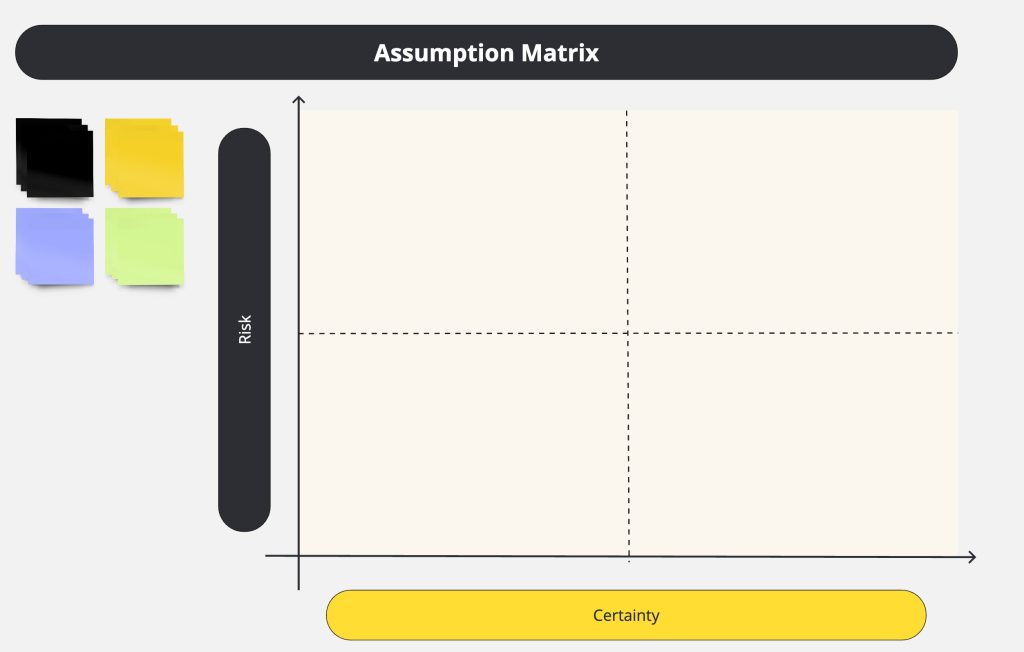Starting a startup at the idea stage feels a bit like cooking a new recipe blindfolded. You’ve got a great concept, but no idea if anyone will actually eat it. This is where assumption mapping comes in—a sanity check before you start serving your gourmet ideas to the world.
Step 1: Identify Assumptions
Think of this as listing all the magical ingredients you believe will make your startup successful. What do you think customers need? Is your market ready for your genius? Will people actually use your product, or will it gather dust in the app store? Write down every wild guess and hopeful dream.
Step 2: Categorize Assumptions
Separate your assumptions into neat little boxes: desirability (will people want this?), feasibility (can we build this without summoning a tech wizard?), viability (can this make money without needing a financial miracle?), and usability (will users navigate it without a PhD in rocket science?).
Step 3: Prioritize Assumptions
Imagine you’re in a startup survival game. The assumptions that could kill your business if wrong are the monsters you need to tackle first. Sort these beasts by how scary (high impact) and unpredictable (high uncertainty) they are.
Step 4: Visual Mapping
Create a visual map. This isn’t art class, but plotting your assumptions on a 2×2 matrix will help you see which ones are both terrifying and mysterious (high impact, high uncertainty). These are the dragons you must slay first.

Step 5: Design Experiments
Now, become a startup scientist. Turn each assumption into a hypothesis, like “If we offer automated budgeting, users will love it.” Then design small, cheap experiments to test these hypotheses. Think MVPs, prototypes, and quick surveys.
Step 6: Execute and Learn
Run your experiments like a mad scientist. Gather data, analyze it, and see if your assumptions hold water or sink like a lead balloon. If validated, great—proceed. If not, adjust your assumptions and try again. Iteration is your best friend.
Example Scenario
Let’s say your startup is developing a new financial management app. Here’s how you’d use assumption mapping:
Assumption: Young professionals need a better way to manage finances.
- Impact: High (if wrong, your product is toast).
- Uncertainty: High (you have no clue if they care).
Hypothesis: Automating budgeting will make them love us.
Experiment: Build a simple version, let a few people try it, and measure their reactions.
Result: If they love it, proceed. If they’re meh, back to the drawing board.
Benefits of Assumption Mapping
- Focused Validation: Stops you from wasting time and money on dead-end ideas.
- Resource Efficiency: Keeps your cash burn low by focusing on what matters.
- Risk Mitigation: Identifies fatal flaws before they kill your startup.
- Informed Decision-Making: Gives you data-driven reasons to pivot or persevere.
In summary, assumption mapping is your crystal ball in the startup world. It won’t guarantee success, but it’ll help you avoid spectacular failures. So, if you’re at the idea stage, whip out that assumption map and start turning those wild guesses into validated truths. Your future self will thank you.
Ready to map your assumptions and conquer the startup world? Dive in and start mapping today. If you need a hand, I’m just a call away.
About the Author
Angkan Mukherjee works in growth strategy for high growth companies and is a graduate of the ESADE business school in Barcelona. Outside work, he volunteers as a mentor at incubators like eWorks and loves getting involved in every aspect of building ventures. He gets excited to talk to others like him and you can find some time to talk to him here.
